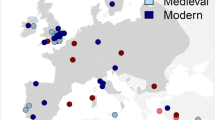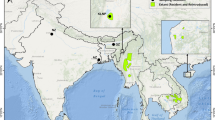Abstract
The giant deer, or ‘Irish elk’, has featured extensively in debates on adaptation, sexual selection, and extinction. Its huge antlers—the largest of any deer species, living or extinct—formed a focus of much past work1,2,3,4. Yet the phylogenetic position of the giant deer has remained an enigma. On the basis of its flattened antlers, the species was previously regarded as closely related to the living fallow deer5,6,7. Recent morphological studies8, however, have challenged that view and placed the giant deer closer to the living red deer or wapiti. Here we present a new phylogenetic analysis encompassing morphological and DNA sequence evidence, and find that both sets of data independently support a sister-group relationship of giant and fallow deer. Our results include the successful extraction and sequencing of DNA from this extinct species, and highlight the value of a joint molecular and morphological approach.
This is a preview of subscription content, access via your institution
Access options
Subscribe to this journal
Receive 51 print issues and online access
$199.00 per year
only $3.90 per issue
Buy this article
- Purchase on Springer Link
- Instant access to full article PDF
Prices may be subject to local taxes which are calculated during checkout


Similar content being viewed by others
References
Gould, S. J. The origin and function of ‘bizarre’ structures: antler size and skull size in the ‘Irish Elk,’ Megaloceros giganteus . Evolution 28, 191–220 (1974)
Moen, R. A., Pastor, J. & Cohen, Y. Antler growth and extinction of Irish Elk. Evol. Ecol. Res. 1, 235–249 (1999)
Geist, V. Deer of the World: Their Evolution, Behavior and Ecology (Swan Hill Press, Shrewsbury, 1999)
Stuart, A. J., Kosintsev, P., Higham, T. F. & Lister, A. M. Pleistocene to Holocene extinction dynamics in giant deer and woolly mammoth. Nature 431, 684–689 (2004)
Lydekker, R. The Deer of all Lands (Rowland Ward, London, 1898)
Millais, J. G. The Mammals of Great Britain and Ireland (Longman, Green & Co., London, 1906)
Reynolds, S. H. Monograph on the British Mammalia of the Pleistocene Period. The Giant Deer 1–58 (Palaeontographical Society Memoir, London, 1929)
Pfeiffer, T. Die Stellung von Dama (Cervidae, Mammalia) im System plesiometacarpaler Hirsche des Pleistozäns. Cour. Forsch.-Inst. Senckenberg 211, 1–218 (1999)
Groves, C. & Grubb, P. in Biology and Management of the Cervidae (ed. Wemmer, C. M.) 21–59 (Smithsonian Institution, Washington, D.C., 1987)
Randi, E., Mucci, N., Pierpaoli, M. & Douzery, E. New phylogenetic perspectives on the Cervidae (Artiodactyla) are provided by the mitochondrial cytochrome b gene. Proc. R. Soc. Lond. B 265, 793–801 (1998)
Pitra, C., Fickel, J., Meijaard, E. & Groves, C. Evolution and phylogeny of Old World deer. Mol. Phylogenet. Evol. 33, 880–895 (2004)
Kishino, H. & Hasegawa, M. Evaluation of the maximum likelihood estimate of the evolutionary tree topologies from DNA sequence data, and the branching order in Hominoidea. J. Mol. Evol. 29, 170–179 (1989)
Guthrie, R. D. Frozen Fauna of the Mammoth Steppe (Univ. of Chicago Press, Chicago, 1990)
Lister, A. M. in Biology and Management of the Cervidae (ed. Wemmer, C. M.) 81–98 (Smithsonian Institution, Washington, DC, 1987)
Azzaroli, A. & Mazza, P. On the possible origin of the Giant Deer genus Megaceroides . Rend. Fis. Acc. Lincei 3(9), 23–32 (1992)
Abbazzi, L. Remarks on the validity of the generic name Praemegaceros Portis 1920, and an overview on Praemegaceros species in Italy. Rend. Fis. Acc. Lincei 15(9), 115–132 (2004)
Croitor, R. & Kostopoulos, D. S. On the systematic position of the large-sized deer from Appolonia, Early Pleistocene, Greece. Palaeontol. Z. 78, 137–159 (2004)
Vislobokova, I. & Hu, C. On the evolution of Megacerines. Vertebr. Palasiat. 28, 150–158 (1990)
Pfeiffer, T. The first complete skeleton of Megaloceros verticornis (Dawkins, 1868) (Cervidae, Mammalia) from Bilshausen (Lower Saxony, Germany): description and phylogenetic implications. Mitt. Mus. Naturk. Berl. Geowiss. 5, 289–308 (2002)
Made, J. v. d. Ungulates from Atapuerca TD6. J. Hum. Evol. 37, 389–413 (1999)
Soergel, W. Cervus megaceros mosbachensis n. sp. und die Stammesgeschichte der Riesenhirsche. Abh. Senck. Naturforsch. Ges. 39, 365–407 (1927)
IUCN, The IUCN Red List of Threatened Species (IUCN, Gland, 2004)
Vogler, U. New light upon the taxonomic status of European and Persian fallow deer on the basis of bone remains from Turkey. Tierarzl. Praxis 25, 100–105 (1997)
Lister, A. M. Evolutionary and ecological origins of British deer. Proc. R. Soc. Edinb. B 82, 205–229 (1984)
Lister, A. M. The morphological distinction between bones and teeth of fallow deer (Dama dama) and red deer (Cervus elaphus). Int. J. Osteoarchaeol. 6, 119–143 (1996)
Swofford, D. L. PAUP* Phylogenetic Analysis using Parsimony (and Other Methods). Version 4.0b10 (Sinauer Associates, Sunderland, Massachusetts, 2002)
Barnes, I., Matheus, P., Shapiro, B., Jensen, D. & Cooper, A. Dynamics of Pleistocene population extinctions in Beringian brown bears. Science 295, 2267–2270 (2002)
MacHugh, D. E., Edwards, C. J., Bailey, J. F., Bancroft, D. R. & Bradley, D. G. The extraction and analysis of ancient DNA from bone and teeth: a survey of current methodologies. Anc. Biomol. 3, 81–102 (2000)
Yang, Z. PAML: a program package for phylogenetic analysis by maximum likelihood. Applics BioSci. 13, 555–556 (1997)
Ronquist, F. & Huelsenbeck, J. P. MRBAYES 3: Bayesian phylogenetic inference under mixed models. Bioinformatics 19, 1572–1574 (2003)
Acknowledgements
We thank A. Currant, A. Friday, D. Hills, P. Jenkins, P. Kosintsev, L. Martin, N. Monaghan, T. Stuart, A. Vorobiev and E. Westwig for sampling and access to material; P. Grubb, D. MacHugh, C. O'hUigin and K. Wolfe for discussion; T. Burke and A. Cooper for laboratory facilities; P. Forey, J. Masters, A. Mitchell and M. Sánchez-Villagra for advice on cladistics; A. Murray and R. Rabinovich for technical assistance; and V. Geist and Stackpole Books for permission to reproduce the drawings in Fig. 2a. C.J.E. was supported by the Irish Research Council for Science, Engineering and Technology Basic Research Grant Scheme. I.A.vP was funded by BBSRC.
Author information
Authors and Affiliations
Corresponding author
Ethics declarations
Competing interests
Sequences are deposited in GenBank under accession numbers AM072730–AM072749. Reprints and permissions information is available at npg.nature.com/reprintsandpermissions. The authors declare no competing financial interests.
Supplementary information
Supplementary Notes
This file contains the Supplementary Methods and Discussion, Supplementary Figures 1 and 2, Supplementary Tables 3-9. This is a detailed account of methods used in both morphological and molecular analysis, with a discussion comparing results with previous studies. Tables and Figures showing sample and radiocarbon details, primer and cloning sequences, distance matrices, and GENBANK accession numbers. (DOC 252 kb)
Supplementary Table S1
Morphological character and character state descriptions; sample sizes and character scores on all taxa. (XLS 53 kb)
Supplementary Table S2
Morphological data transformed ready for analysis. (XLS 33 kb)
Rights and permissions
About this article
Cite this article
Lister, A., Edwards, C., Nock, D. et al. The phylogenetic position of the ‘giant deer’ Megaloceros giganteus. Nature 438, 850–853 (2005). https://doi.org/10.1038/nature04134
Received:
Accepted:
Published:
Issue Date:
DOI: https://doi.org/10.1038/nature04134
This article is cited by
-
Antler Allometry, the Irish Elk and Gould Revisited
Evolutionary Biology (2024)
-
A Pleistocene Fight Club revealed by the palaeobiological study of the Dama-like deer record from Pantalla (Italy)
Scientific Reports (2022)
-
Bony labyrinth morphology clarifies the origin and evolution of deer
Scientific Reports (2017)
-
Growth in fossil and extant deer and implications for body size and life history evolution
BMC Evolutionary Biology (2015)
-
Mitochondrial Genomes of Giant Deers Suggest their Late Survival in Central Europe
Scientific Reports (2015)
Comments
By submitting a comment you agree to abide by our Terms and Community Guidelines. If you find something abusive or that does not comply with our terms or guidelines please flag it as inappropriate.



